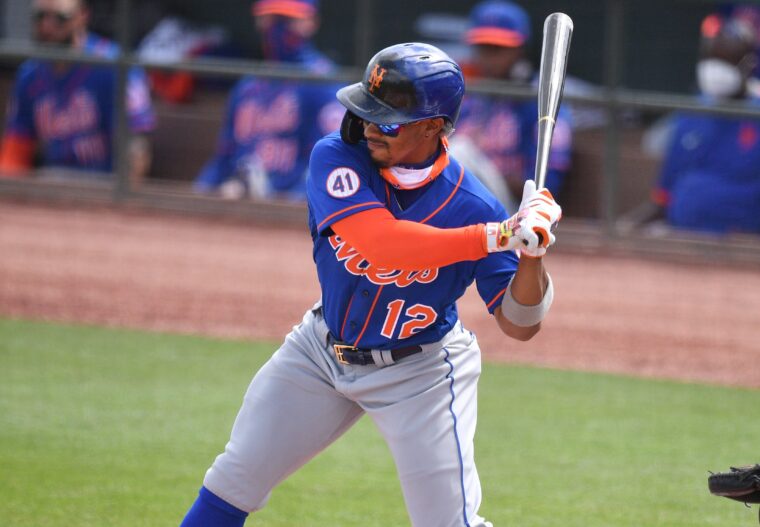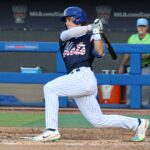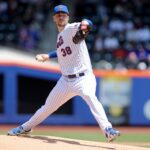
Mandatory Credit: Ron Chenoy-USA TODAY Sports
The New York Mets were one of the league’s most active teams this past offseason and arguably made the biggest acquisition by trading for shortstop Francisco Lindor before eventually signing him to a 10-year, $341 million extension. But nearly a month into his first season in Queens, he’s already starting to hear some boos rain down on him because of a slow start.
Is it warranted? His performance at the plate has been far from great — it’s hard to justify a .203/.317/.261 line with one home run, three RBI, and a 72 wRC+ through 83 plate appearances — but I personally don’t like booing players. I mean, baseball is hard and it’s not as if he’s trying to play this way, but then again, this is New York and baseball is a results-based business, so I’m also not surprised there’s some frustration in the stands at Citi Field.
Even with that in mind, the regular season is very long. With a 9-10 record through 19 games, there’s still just over 88% of the 162-game schedule left to play. So, yes, it’s understandable to be frustrated because we’re not seeing this offense and its expected main contributors doing what they “should” be doing, but there’s a whole lotta ballgame left to play.
Plus, with everything the Mets have dealt with through the early portion of this season, they’re still just 0.5 games out of first place in the National League East, which is really all that matters as they trudge forward in their upcoming stretch of 10 games in 10 days, which starts Friday. This is a chance for the offense to finally get into some sort of rhythm, and Lindor could certainly use a little bit of that.
He’s Kinda Dealt With This Before
As Lindor endures this slow start to his Mets career, I was curious as to how his performance over the past two full seasons of play looked by the time the calendar flipped from April to May. While the slump he’s currently in is easily the worst of all, this is not the first time Lindor has put together a slow first month (according to his own standards and past performances).
Through his first 126 plate appearances in 2018, Lindor was slashing .245/.331/.409, which gave him an even 100 wRC+. Although that’s not shabby, nobody views him as simply an average offensive producer. He then went on a tear for the three months that followed, hitting .308/.382/.617 with a 165 wRC+. The 2018 campaign actually ended up being the shortstop’s best overall performance to date, as he posted single-season career highs in OPS (.871), homers (38), RBI (92), runs scored (129), wRC+ (132), and fWAR (7.7).
The 2019 season was different because an ankle sprain and a calf strain forced Lindor to the injured list to start the year. So, he only compiled 38 plate appearances before April was through. But still, he posted just a .723 OPS and a 76 wRC+. Despite this, Lindor managed to finish the year with a 115 wRC+ with a .854 OPS, 32 home runs, 74 RBI, and 4.5 fWAR.
When looking at his monthly splits at the plate over his career, Lindor’s 106 wRC+ and .781 OPS are both the second-worst marks of any month for him during the season (only June has been worse). His .439 slugging percentage in March/April has been the worst.

Photo: NY Mets
The Differences Between Then and Now
When comparing Lindor’s slower starts from 2018-19 to the current season, one thing jumps out — the lack of power and hard contact.
In 2018, he still collected 10 extra-base hits (six doubles, four homers) and paired it with a 40.7% hard-hit rate. Despite just having 38 April plate appearances in 2019, Lindor managed to hit three home runs off the strength of a 44.8% fly-ball rate and a 44.8% hard-hit rate.
So far this year? Well, the above categories haven’t been nearly as encouraging. He’s recorded just two extra-base hits (one double and one homer), which has resulted in a ghastly .058 ISO. He’s also not pulling the ball nearly as much as he has in the past (40.3% for his career, 31.1% so far in ’21), along with producing a 53.3% ground-ball rate, and a soft-hit rate (21.3%) that’s almost higher than his hard-hit rate (24.3%).
What’s Hasn’t Been Bad During The Struggles
Even though it’d simply be better if Lindor was hitting, it’s at least nice to see these struggles haven’t traveled out into the field with him. As it currently stands, his 4 Outs Above Average is tied for the league lead at his position. That’s a far cry from how the Mets have performed in that area over recent years, and that type of performance is definitely appreciated by the pitching staff.
When looking at Lindor’s approach at the plate, his walk rate (13.3%) is actually outpacing his strikeout rate (12.0%). While it’s a very small victory, he’s not pressing so much that he’s sacrificing his plate discipline in order to get himself going. He needs to trust his process with regard to what’s made him so good over the years, and it’s clear he’s been able to do that.
It wouldn’t hurt to get a little more aggressive in the strike zone, though. Lindor’s 30.3% chase rate has improved a smidge compared to last year (34.3%), but his swing rate on strikes has taken a dive down to 63.2%. This is a number that hasn’t dipped below 65.0% during any single season of his career, and it’s settled in above 70.0% each of the last two years.
However, what it all boils down to is that it’s super freakin’ early in the season, and Lindor has been here before when it comes to slower starts, to varying degrees. He’s been around long enough to know the good stuff is eventually going to happen if he sticks to his plan while making slight adjustments. It appears that he’s generally stuck to his approach at the plate, and now it’s just time for something else to click so those boo birds can fly away and bother someone else.
















